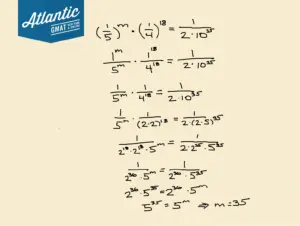If (1/5)^m * (1/4)^18 = 1/(2*(10)^35), then m = ? GMAT Explanation + Additional Examples!
If (1/5)^m * (1/4)^18 = 1/(2*(10)^35), then m = ?
(A) 17
(B) 18
(C) 34
(D) 35
(E) 36
Define the question: m = ?
The basic idea is: simplify the expression to determine m. For exponents it’s likely we’ll be doing some factoring.
Even if this looks confusing, just keep with it. Basic step by step simple rules will get you there!
Raising to a power means: multiply your exponents!
When you have a fraction raised to an exponent, you can distribute the exponent to the numerator and the denominator. Let’s do that:
1 taken to any power is just 1, so we end up with
One technique that will help with this problem (and in general on the GMAT) is thinking in terms of prime factors.
Here, we are working with the numbers 5, 4, 2, and 10, so let’s break them down to their prime factors and see if that simplifies things.
2 and 5 are already prime, so we are good there.
4 has a prime factorization of 2 * 2, and 10 has a prime factorization of 2 * 5.
This means every number we have left can be factored down to a combination of 2’s and 5’s. Let’s do this factorization in our problem.
Here, we have a product taken to a power: . In this case, you can distribute the exponent to both terms. So we get
.
We can do the same for . We distribute the exponent and get
. Let’s put these back into our original equation.
Now, when you have two terms with the same base, you add their exponents together. Let’s look at . These both have the same base of 2. So we just add their exponents:
.
We can also do the same for . The ‘2’ here does not have a visible exponent. But this just means it’s exponent is 1! So let’s add the exponents like before:
.
Let’s put these back into our original equation.
At this point, both sides look almost identical. The only difference is one side has 5^m and the other has 5^35. So, we can see that m must be 35! Let’s solve to the end just to make sure.
We can cross multiply to get rid of the fractions. Doing so, we get:
Multiplying by 1 on both sides just gives us:
Now, we divide both sides by to get:
So m must be 35.
Answer: D
